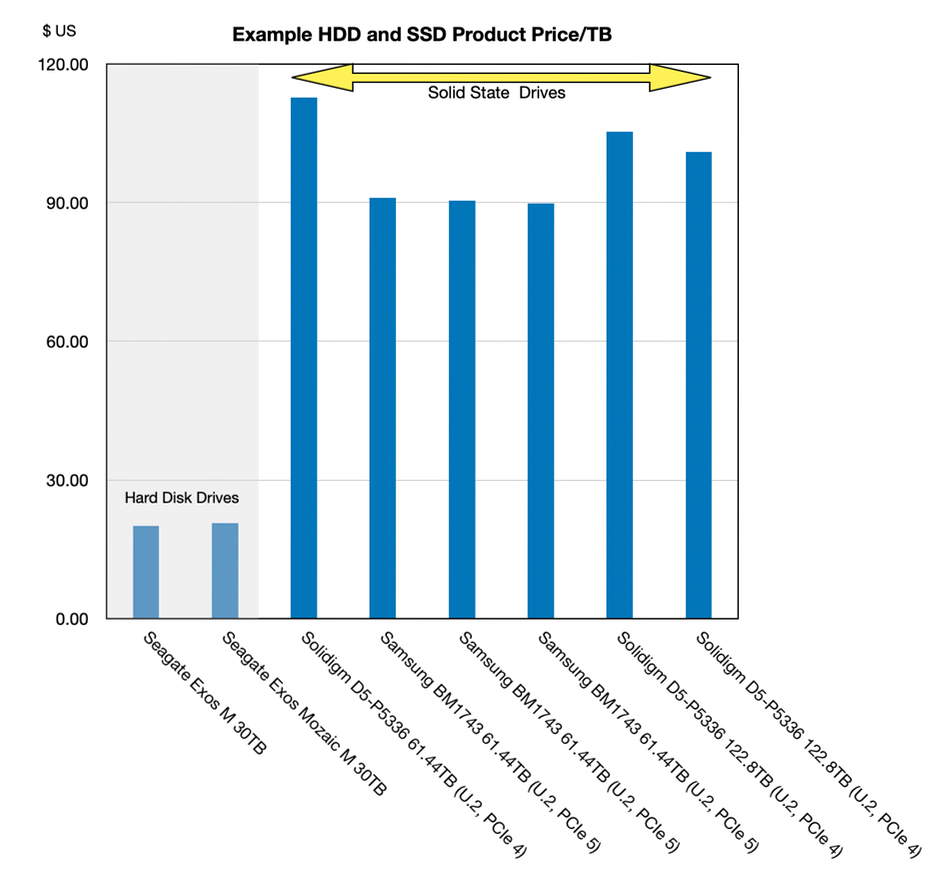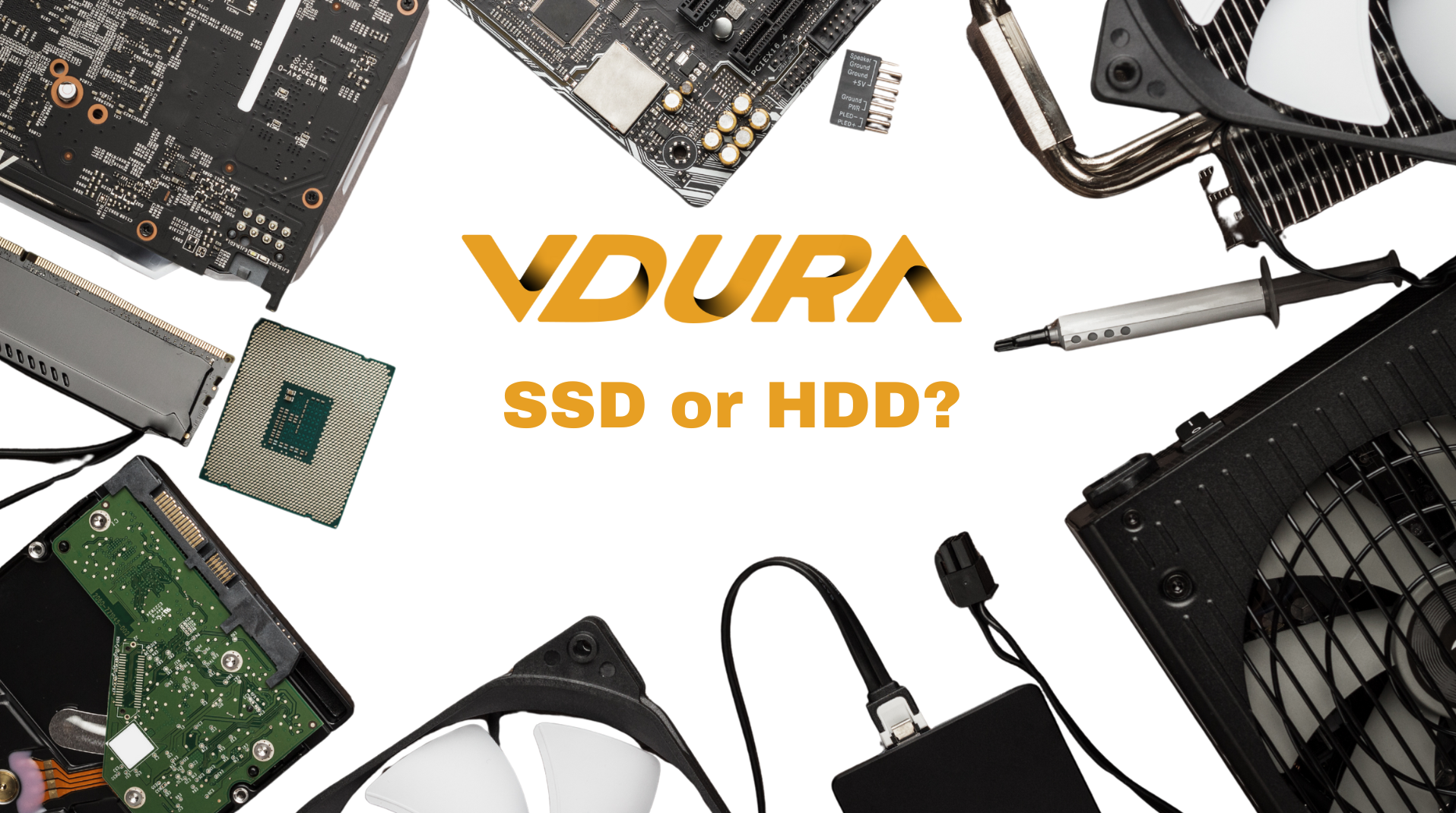Chris Mellor, Aug 14, 2025 (Block & Files) –An NVMe-SSD + HDD architecture on a true parallel file system wins on $/TB, watts/TB, and long-term TCO over SSD-only or HDD-only architectures—without giving up GPU performance.
So says HPC/AI storage supplier VDURA’s Chris Girard, VP of Product Management. He has taken a look at the Solidigm/VAST SSD-vs HDD TCO claims and the Pure Storage SSD superiority over disk in power-efficiency and carbon emissions study, and says they miss the point: “$/TB reality still favors capacity HDD, by a wide margin. 30 TB enterprise HDDs are now broadly available and are ~$20/TB. Ultra-high-capacity enterprise SSDs (61.44TB–122.88TB QLC) list for thousands of dollars per drive. Recent retail/contract pricing is ~$90-$112/TB.”
He provides a table to illustrate this;


We charted the Cost $/TB column to bring out the differences;
Girard declares: “That pricing gulf (4.5 – 6x cost difference $/TB) is why Hyperscalers and enterprise customers continue to place the bulk of warm/cold data on HDD, and why VDURA customers buy flash for performance, disk for capacity, in one system.”

He moves on to the 10-year TCO data from Solidigm/VAST and says: “The Solidigm/VAST model assumes two full HDD fleet replacements in 10 years and credits VAST software with dramatic “effective capacity” via dedupe + compression to shrink the SSD count. As your article notes, if you apply a more realistic six-year average life for HDDs (aligned with recent Backblaze updates) the claimed advantage narrows materially. (VDURA sees some customers in hybrid environments operating for over 10 years)”
Girard points out: “More importantly, data-reduction ratios are workload-dependent. … Designing a TCO case around fixed 2.5:1 savings risks misrepresenting mixed AI/HPC data. VDURA’s software suite includes equivalent data reduction technologies as an umbrella capability, optimized for both all-flash and hybrid environments. We’ve seen real-world ratios exceeding 2:1 in enterprise workloads, allowing us to achieve similar efficiencies.”
On that basis: “Without these, the [Solidigm/VAST] study admits SSD TCO would balloon to $66.13 million. But with VDURA’s tools normalizing the data reduction factor and a 10-year lifecycle without refreshes, our flexible hybrid systems not only match that efficiency but leverage HDDs’ inherent cost-per-TB edge to deliver substantially lower upfront acquisition costs and overall TCO compared to all-flash systems.
Turning to power-efficiency he provides electricity use numbers;
- 61.44 TB enterprise SSDs (e.g., Solidigm D5-P5336) draw ~25 W active and ~5 W idle — equal to roughly 0.33–0.41 W/TB active and ~0.08 W/TB idle.
- 30 TB HDDs draw ~6.9 W average active and ~9.5 W max, or about 0.23–0.32 W/TB at today’s densities.
Girard comments: “For hot, high-IOPS datasets, flash’s active efficiency and latency advantages are unmatched. But for warm or cold data sitting in capacity tiers, HDDs can match or even beat large QLC SSDs on watts per terabyte, especially when systems are optimized for capacity per rack rather than peak IOPS. Hybrid architectures exploit this balance, delivering flash where performance is critical and HDD where cost-per-TB and energy efficiency matter most.”
Carbon emissions are next in Girard’s sights: “Pure Storage’s carbon/power claims rely on selective comparisons. [It] uses device-level 10 MB/sec/TB benchmarks that ignore system-level throughput and hybrid tiering. [It] shortchanges HDDs (and even SSDs) with 5-year lifespans while granting DFMs (Direct Flash Module) 10 years, skewing lifecycle emissions math.”
Also Pure: “Compares “modest” 2RU x 24-drive HDD enclosures to denser 5RU DFM configs, ignoring that real-world 4U HDD enclosures pack 100+ drives, boosting density 68 percent and slashing rack space, power, and CO₂e by up to 73 percent versus all-flash.”
In Girard’s view: “VDURA delivers one parallel file system with an NVMe flash first design dynamically balancing hot data on SSDs and cold data on high-capacity HDDs. We minimize wear on spinning disks and eliminate the need for multiple refresh cycles. This approach drives a significantly lower 10-year TCO for 1 EB than the study’s HDD baseline, and beats all-flash at scale, by fine-tuning the SSD/HDD mix for the lowest overall cost without massive upfront capital.”
VDURA has a 10-year drive assurance scheme for both flash and disk drives. Its “hybrid design has delivered up to 60 percent lower 10-year TCO versus all-flash proposals that sized on optimistic reduction ratios and premium QLC pricing. Power, space, and media refresh are where the savings accrue.”
But VDURA also has, Girard asserts, a performance advantage as well: “VDURA solutions outperform VAST and Pure on both a per-node basis and an aggregate cluster basis, delivering superior write and read throughput, IOPS, and metadata scalability—thanks to being a true parallel file system that is easy to deploy, use, and manage even at exabyte scale.”
He concludes: “Enterprises don’t need to choose between cost, capability, and environmental impact; our tailored solutions provide all three.” Or performance either.
